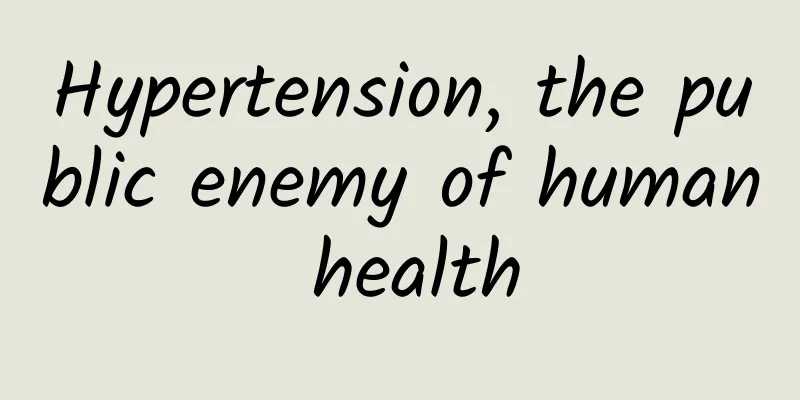Hypertension, the public enemy of human health

|
Author: Du Yanmei Beijing Hui Hospital Reviewer: Wang Changyuan, Chief Physician, Xuanwu Hospital, Capital Medical University Cardiovascular and cerebrovascular diseases are the leading cause of morbidity and mortality in the Chinese population. Hypertension is the leading cause of acute cardiovascular and cerebrovascular diseases, and the prevention and treatment of hypertension is the top priority for the prevention and treatment of acute cardiovascular and cerebrovascular diseases. According to the results of a hypertension survey published in 2018, there are about 245 million hypertensive patients in my country, and the prevalence rate of those over 18 years old is 27.9%. One in every four adults has hypertension, but the control rate of hypertension is only 16.8%. Most hypertensive patients have primary hypertension, with unknown causes and a lack of clear and effective etiological intervention strategies. However, if everyone can pay more attention to their physical health and improve the awareness, treatment and control rates of hypertension, then the occurrence of cardiovascular diseases will definitely be reduced in the future. In addition, if the prevention and treatment strategies for hypertension are moved forward, more attention is paid to the detection and early intervention of pre-hypertension in young and middle-aged people, and the occurrence of hypertension is reduced, the probability of cardiovascular disease in the future will also be greatly reduced. 1. Definition of Hypertension Figure 1 Copyright image, no permission to reprint The heart keeps beating, pushing blood to the whole body. The pressure of the flowing blood on the blood vessel wall is the blood pressure. If the blood pressure is too high, the blood vessels are easily damaged or even ruptured. This is the harm of high blood pressure. So what is the blood pressure value considered high blood pressure? Under normal circumstances, the systolic blood pressure does not exceed 120 mmHg. The systolic blood pressure of hypertensive patients can increase to more than 140 mmHg, or even higher. The diagnosis of hypertension includes office blood pressure and out-of-office blood pressure, and the main points are as follows. 1. Clinic blood pressure: Without the use of antihypertensive drugs, three times of systolic blood pressure greater than or equal to 140 mmHg and/or diastolic blood pressure greater than or equal to 90 mmHg on different days can be diagnosed as hypertension. 2.24-hour dynamic blood pressure: Hypertension can be diagnosed if the average throughout the day is greater than or equal to 130/80 mmHg, greater than or equal to 135/85 mmHg during the day, and greater than or equal to 120/70 mmHg at night. 3. Home blood pressure: Monitor blood pressure for 7 consecutive days. Hypertension can be diagnosed if the blood pressure is greater than or equal to 135/85 mmHg. 2. The harm of high blood pressure To use an analogy, our blood vessels are like a river, and our blood is like the water in the river. Under normal circumstances, the water in the river flows forward continuously, flowing to the brain, flowing to the heart, and flowing to all parts of the body, continuously delivering blood rich in oxygen and other nutrients to various organs to ensure their normal functioning. Once high blood pressure occurs, it will lead to the following hazards. (1) Hypertension causes cerebral hemorrhage: If the water pressure in a river is too high, the water flow in the river will be too turbulent, which may damage the river bank and cause the river water to flow out. Similarly, when the blood pressure is too high, the blood in the blood vessels will tear due to the high pressure, and the blood will flow out of the blood vessels. This is how cerebral hemorrhage occurs. (2) Hypertension causes insufficient blood supply to organs such as the heart or brain: Let’s take a river as an example. A river flows for thousands of miles and has many bends or forks. The riverbanks at these locations are most likely to be damaged by the river water, forming defects. The same is true for arteries. The blood pressure of patients with hypertension is very high. Over time, it is easy to damage the endothelium of the blood vessels at the bends or forks of the blood vessels, forming small ruptures. After a small rupture occurs, cholesterol in the blood will take the opportunity to enter the blood vessel wall, gradually accumulate and increase, and form atherosclerotic plaques. If not effectively treated, the plaques will become larger and larger, leading to stenosis of the blood vessels. The blood flow through this area will decrease, and then insufficient blood supply to organs such as the heart or brain will occur. (3) Hypertension causes acute myocardial infarction and cerebral infarction: The sudden rupture of plaques in blood vessels will quickly block the blood vessels, completely interrupting blood flow. The heart or brain will completely lose blood supply, and necrosis will occur, leading to acute myocardial infarction and cerebral infarction. (4) Hypertension causes ventricular hypertrophy and heart failure: Our heart is a blood pump that continuously transports oxygen-rich blood from the heart to the arteries, and then returns to the heart through the capillaries and veins throughout the body. The pressure in the arteries of hypertensive patients increases, and the resistance that the heart needs to resist when ejecting blood into the blood vessels becomes greater and greater. Over time, the walls of the heart will become thicker, forming ventricular hypertrophy. As a result, the movement of the heart is not as flexible as before, and heart failure is very likely to occur. (5) Hypertension causes renal failure: The kidneys are like the human body’s filter, which constantly removes various metabolic wastes. Long-term untreated hypertension will damage the filter, making it difficult to remove metabolic wastes, leading to renal failure. (6) Hypertension causes aortic dissection: The walls of large and medium-sized blood vessels are divided into three layers. Severe hypertension can also tear the blood vessel wall, allowing blood to enter the interlayer of the blood vessel wall, forming aortic dissection. Aortic dissection is prone to rupture and cause death. The prognosis is extremely poor and the mortality rate is extremely high. 3. Populations susceptible to hypertension Theoretically, everyone has the possibility of developing hypertension, but the following groups of people are more likely to develop hypertension. Therefore, it is even more important to strengthen blood pressure monitoring and actively prevent hypertension. (1) People with high normal blood pressure (systolic blood pressure 120-139 mmHg and/or diastolic blood pressure 80-89 mmHg). (2) One or both parents suffer from hypertension. (3) Overweight and obesity. (4) Frequent heavy drinking. (5) High-salt diet. (6) Long-term mental stress, lack of sleep, and irregular lifestyle. (7) Often sitting in the office, doing little physical activity or almost no exercise. (8) Sleep apnea syndrome patients snore loudly during sleep and always hold their breath. Such people will be in a state of severe hypoxia during sleep, which will promote the occurrence of high blood pressure over time. (9) Long-term use of oral contraceptives, hormones, painkillers and other drugs can also cause hypertension. 4. Prevention of Hypertension Figure 2 Copyright image, no permission to reprint Hypertension is a "lifestyle disease" and changing your unhealthy lifestyle is helpful to prevent and control hypertension. For the above-mentioned susceptible groups, blood pressure should be measured several times a year to understand the changes in blood pressure. At the same time, the following matters need to be noted. (1) Reduce sodium intake, increase potassium intake, eat less salt and pickled foods, eat more green leafy vegetables and fruits, eat low-sodium salt, and control daily salt intake to less than 6 grams, which can reduce blood pressure by 2 to 8 mmHg. (2) Control your weight. For people who are obviously obese, losing weight can lower blood pressure by 5 to 20 mmHg. (3) Quit smoking. Long-term smokers have an increased risk of developing hypertension. Quitting smoking can reduce blood pressure by 1 to 2 mmHg. (4) Quit drinking. Drinking a lot of alcohol regularly can increase blood pressure. After quitting drinking, blood pressure can drop by 2 to 4 mmHg. (5) Increase physical exercise. Regular exercise not only helps to lose weight, but also lowers blood pressure. Developing the habit of outdoor exercise every day can reduce blood pressure by 4 to 9 mmHg. (6) Live a regular life, get enough sleep, reduce mental stress, and maintain psychological balance. References [1] National Center for Cardiovascular Disease. China Cardiovascular Health and Disease Report 2019[M]. Beijing: Science Press, 2020. [2] Chinese Hypertension Prevention and Treatment Guidelines Revision Committee, Hypertension Alliance, Chinese Medical Association Cardiology Branch, etc. Chinese Hypertension Prevention and Treatment Guidelines (2018 Revised Edition) [J]. Chinese Journal of Cardiology, 2019, 24(1): 1-46. |
Recommend
Is interstitial lung disease a large category of diseases? How is it diagnosed and treated?
Author: Fang Baomin, Chief Physician, Beijing Hos...
Positive cervical screening test
When the result of cervical screening is positive...
Can pregnant women drink yogurt?
Yogurt is a healthy drink that most young people ...
Does using mobile phone during pregnancy affect the baby?
Mobile phones have become one of the important co...
Is it normal to bleed a lot on the first day of abortion?
Artificial abortion is a very common surgical pro...
Can winter bamboo shoots be stored in the refrigerator? Tips on how to find bamboo shoots when digging winter bamboo shoots
Whether winter bamboo shoots are fresh or not is ...
I haven't had my period for ten days after stopping Yasmin.
As a new type of emergency contraception, more an...
When having sex with my husband, there is a lot of water below
Girls who have sexual intercourse for the first t...
What to eat after miscarriage?
What to eat after miscarriage is common knowledge...
eMarketer: Smartphone users in China are expected to account for 49.1% of the total population in 2018
199IT original compilation eMarketer estimates th...
22 years old uterine fibroids
Most women who suffer from uterine fibroids are o...
Patients with hypertension need to understand these five points, the second point is very important!
Author: Zhong Jingbai, Chief Physician, Xiyuan Ho...
I feel dizzy when I wear a turtleneck sweater. It turns out there’s something wrong with my neck!
Review expert: Yin Tielun, deputy chief physician...
How often does the pain come?
Pregnant women will become very anxious when they...
What is subcutaneous contraception?
There are so many ways of contraception, such as ...







![[Medical Q&A] Are tinea corporis and eczema the same thing?](/upload/images/67f0ff59a982d.webp)

